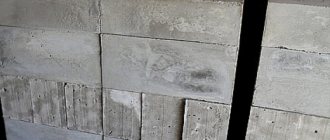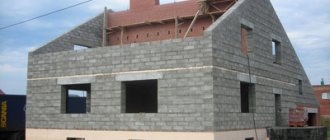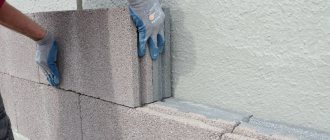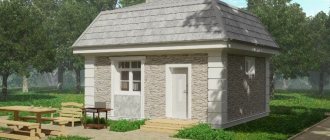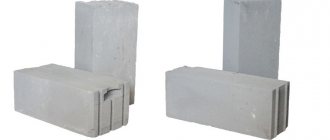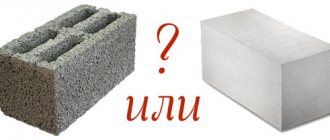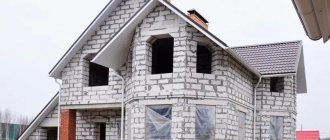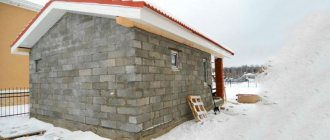Blocks are combined by type and subtype (for example, foam and aerated concrete), and are created using modern technologies. They are widely used for the construction of walls in all countries of the world, as they are valued for their technical characteristics and quality of technology.
What types of blocks are most popular on the territory of the Russian Federation, what they are, and how to distinguish them from each other by eye, what is the difference, which stone is stronger, warmer, lighter - we suggest you familiarize yourself with the presented article.
Building blocks - what are they?
Modern blocks for construction are made in the shape of a rectangular parallelepiped. The dimensions of the elements are much larger than standard bricks.
Types of blocks for construction differ in a number of parameters:
- dimensions;
- designs;
- the type of filler used;
- purpose;
- manufacturing technologies;
- masonry features;
- technical parameters.
When choosing blocks, you should focus on the specific purpose of the building or structure being constructed.
Advantages of most types of blocks for construction compared to bricks:
- minimum construction period;
- reduction in labor requirements;
- reduced loads on the base;
- improved thermal insulation properties;
- no need for finishing coating.
timber
Timber is a universal natural building material, which is made from solid wood (solid timber) or by gluing together several lamellas (laminated veneer lumber). The material has high precision geometric shapes (rectangular or square cross-section), minimal shrinkage (with sufficient drying), and significant heat and sound insulation. Also, buildings made of timber look neat and well-groomed, which allows you to do without external decoration.
Advantages:
- environmental friendliness
- aesthetics
- high bending strength
- significant insulation rates
- high construction speed
Flaws:
- susceptibility to rotting, fungi, insects
- low moisture resistance
- high flammability of the material
- the need for regular protective treatment
- significant cost of materials
Building blocks: types and characteristics
Considering what types of blocks there are for construction, the first criterion for dividing into groups is the nature of the origin of the material:
- artificial. Production is carried out by mixing mixtures. They are convenient due to the possibility of obtaining different sizes, the mixture is poured into the desired shapes, after hardening the blocks are ready for use;
- natural. For production, technologies of polishing natural materials are used, usually based on various types of stone. They are intended for finishing work.
The cheapest type of blocks for construction is artificial, which includes:
- concrete;
- a mixture of expanded clay and concrete;
- blocks with polystyrene and concrete;
- gas silicate;
- foam concrete.
The correct choice of building materials for thermal insulation properties will avoid additional costs for insulation.
Building blocks differ in purpose and are used for:
- laying the foundation;
- erection of walls;
- thermal insulation of the room.
Based on their design, the following types of blocks are distinguished:
- full-bodied. They are integral and do not have voids, which is why they have greater weight and increased strength. They are used to build walls and form foundations. Dimensions of such blocks: width - 30-60 cm, length - 88, 118, 238 cm and height - 28, 58 cm;
- hollow. They are distinguished by the presence of several air pockets; they are less durable, but lightweight and have increased thermal parameters. Dimensions: width – 40-60 cm, length – 238 cm, height – 58 cm;
- smooth. They are used for decorative coatings, as they have a perfectly smooth surface and do not require finishing work;
- corrugated. Manufactured with one or more rough surfaces. They are always used for the construction of load-bearing structures and further processing. The main advantage is better adhesion to plaster.
Modern blocks for construction include various fillers.
Almost all include a certain amount of Portland cement and sand, and additionally add:
Building blocks are a good alternative to other materials for constructing buildings
- clay;
- slaked lime;
- expanded clay granules;
- slags of various origins;
- wood shavings or sawdust;
- inclusions of granite;
- polystyrene crumbs.
When considering what types of blocks there are for building walls, you can get confused if you don’t know the basic selection parameters.
When planning construction, blocks for construction with the following characteristics are selected:
- strength. Indicates the resistance of the material to compressive loads without damage;
- level of thermal conductivity. As the indicator decreases, the amount of heat retained indoors increases;
- frost resistance. The indicator is a reflection of the number of freezing and thawing cycles while maintaining the original structure of the material;
- density. Strength changes depending on the level of density. Denser varieties are highly durable and are used for the construction of walls in highly loaded buildings, but lead to an increase in thermal conductivity;
- water absorption coefficient. Reflects the ability to absorb moisture. Species with a high coefficient require additional cladding.
Building blocks come in different types
Opinions about aerated concrete
“I decided to use gas blocks to build my small one-story house (80 m2). I didn’t load the walls with concrete slabs, I made wooden floors and laid unloading armored belts. Aerated concrete actually has low thermal conductivity, so insulation is not required for our climate zone. During the heating season, 1,300 cubic meters of gas were consumed, including heating water and cooking.”
Petr Menshov, Taganrog.
“While visiting forums, I came across several negative reviews from builders about aerated concrete houses. For good insulation, the minimum wall thickness in the middle zone should be 60 cm or 30 cm with the installation of polystyrene foam or mineral wool - this leads to a significant increase in cost and weight of the house. The disadvantages do not end there: to distribute the weight, you need a massive foundation, and to protect it from moisture, you cannot do without exterior finishing. In general, the final price of the building will be quite high.”
Pavel, Ekaterinburg.
“Take into account my opinion as a builder. I have already laid out 6 aerated concrete houses (block D500, dimensions 625x250x375), none of them have cracked, and the very first one has been standing for 10 years. Of course, you shouldn’t skimp on the foundation, then the walls will be fine. For thermal insulation and protection from atmospheric influences, cover the aerated blocks with facing bricks (maintaining a ventilation gap using plastic anchors). In addition, I advise you to buy plastic reinforcement, since aerated concrete contains lime, and it causes the metal to rust.”
Egor Vasiliev, Ufa.
“When reading reviews, critically evaluate the advantages and disadvantages of aerated concrete. An important point: to prevent moisture from accumulating, do not overdo it with insulation. In any case, do not attach the parabarrier from the outside! Otherwise, you will have to install internal ventilation or keep the windows in ventilation mode. The optimal block sizes are 200x300x600 mm.”
Fedor Golubev, Moscow.
“Don’t forget that it is difficult to install cladding on aerated blocks. Aerated concrete crumbles when screwing in regular dowels; chemical adhesive anchors are needed (price per piece is at least 60 rubles). As a specialist, I will also note the following disadvantages: low frost resistance, undesirability of use in wet rooms. If you don’t apply a special primer, the plaster will fall off.”
Yaroslav, Samara.
https://youtube.com/watch?v=d_it_M2I7WM
Price
When choosing a material, you should focus on its minimum density required for the given work and the reputability of the company. The larger the manufacturer, the more advanced the technology and the less likely it is to purchase a low-quality gas block. To reduce costs, from two equal options, choose a supplier with warehouses located closer to the consumer: this will save on delivery.
Prices for various types in Moscow and the Moscow region are shown in the table:
| Company | Brand of aerated concrete | Price per 1 m3, rubles | Block type |
| ProfiBlock | D500 | 3500-4600 | smooth |
| Smart | D400 | 2740-4750 | smooth |
| Bonolit | D500 | 4300 | smooth |
| StroyPartner | D500 | 4600 | tongue-and-groove |
Expanded clay concrete blocks
The technical standard for the production of expanded clay concrete type building blocks is GOST 6133-99. The standard stipulates that the group includes heavy, light and fine-grained concrete, which is always made hollow. The thickness of the walls on the outside is not less than 2 cm, and the weight is not more than 31 kg.
Expanded clay concrete elements are used for the following construction purposes:
- creating partitions;
- masonry walls in low-rise buildings;
- construction of soundproof partitions;
- organization of natural ventilation;
- formation of foundations of wooden log houses.
For construction, 2 types of blocks are used:
- facial It has one (side) or two (side and end) facial planes;
- private There are no decorative surfaces.
According to the place of masonry, the elements are divided into corner, ligament and row. The assortment includes blocks with sizes:
- width: 7-49.5 cm;
- length: 12-45 cm;
- height: 19 and 24 cm.
The material has a strength of 400-1800 kg/m3.
Expanded clay concrete is a block made by vibrocompression, which contains: cement, sand, expanded clay, water
Strengthening external walls
Aerated concrete does not tolerate mechanical loads well. If the pressure can be balanced by increasing the thickness of the structure and thereby increasing its load-bearing capacity, then multidirectional forces (tension) can be compensated only by reinforcement. For external walls, this is a common practice that is part of the technological process of laying aerated blocks. Every 3rd or 4th row is reinforced by passing through 2 grooves (ditches) and placing reinforcing bars in them. They encircle the entire perimeter of the building, forming a reinforcement belt. The depth of the grooves corresponds to the diameter of the reinforcement (or a little more, 2-4 mm). The rods are laid using an adhesive composition that is used to connect the gas blocks during laying.
In addition to rods, masonry mesh is used, although this option does not provide sufficient reinforcement for walls made of aerated blocks. The metal mesh is too thick and excessively increases the thickness of the seam between the rows. Fiberglass mesh is thin, but it stretches easily and cannot protect the masonry from tensile loads. Therefore, to compensate for multidirectional forces, it is recommended to lay rods. They are especially necessary in regions with clay soils prone to frost heaving. Any movement of the soil causes deformation of the foundation, which, in turn, affects the walls made of aerated concrete. The appearance of vertical cracks is a consequence of poor-quality (or missing) wall reinforcement.
Polystyrene concrete blocks
The production of polystyrene concrete is standardized in GOST 51263-99. According to the standard, polystyrene concrete building elements made from sand, cement and water always include polystyrene foam granules.
The main areas of application of expanded polystyrene:
- installation of load-bearing walls;
- creation of enclosing, frame buildings;
- insulation of the house.
Polystyrene concrete is used to form the foundation, facade, roof and insulation of the house; the blocks are characterized by good heat transfer and ease of installation. In terms of thermal conductivity, the foam block is similar to polystyrene concrete elements, but is significantly inferior to them in strength. The density of the material ranges from 150-600 kg/m3.
Most often used for the construction of buildings of any size that require thermal insulation.
Sold as:
- slabs: 60x30x9-20 cm;
- wall blocks: 60x30x20-25 cm;
- elements for partitions: 60x30x8-12 cm.
Building blocks made of polystyrene concrete are lightweight concrete using cement binder and foamed polystyrene as filler.
Gas silicate building blocks: types and properties
When choosing aerated concrete and gas silicate elements, they prefer blocks for small objects and walls or slabs for floors. At the legislative level it is standardized by GOST 31360-2007. Gas silicate elements are made from unreinforced cellular concrete. Designed for the construction of partitions and walls.
Manufacturing technology implies the possibility of producing blocks with blind and through holes, and grip pockets. Manufacturers produce U-shapes in limited editions.
Manufacturing is carried out using two methods:
- autoclave method. To dry the material, the influence of steam is used; it is supplied under high pressure. The result is high strength characteristics and resistance to shrinkage during the drying process;
- non-autoclave method. Hardening is carried out under natural conditions. Characterized by significant shrinkage during the solidification process. It is used less often in buildings due to reduced strength, but is cheaper.
You can find out which gas silicate block is by the batch marking. During the masonry process, installation of a vapor barrier film is not required if the air humidity does not exceed 75%. The blocks have standard dimensions: 62.5x50x50 cm. The slabs are made in dimensions: 150x100x60 cm.
Aerated concrete blocks are connected using a special glue, this is facilitated by their ideal geometric shape with an error tolerance of no more than 2 mm
The material is valued due to its technical characteristics:
- arithmetic mean density – up to D700;
- compression force to deformation – from B1.5;
- thermal conductivity level: 0.08-0.1 W/m;
- shrinkage during the hardening process and vapor permeability - corresponds to GOST 31359;
- frost resistance: for external walls F25, for other tasks F15.
The weight of one block starts from 17 kg and reaches 40 kg.
Ceramic block
Ceramic block is a material that is a modification of ordinary brick. It is made from the same source material, aged and fired under approximately the same conditions as ordinary ceramic bricks. Externally they are similar, the difference is the internal structure of the block - it has many through voids located on the working surfaces.
At the same time, externally, in a photo, or by directly examining the wall, it is impossible to accurately determine whether it is a facing brick or a ceramic block. The only difference for an experienced person may be the size - the blocks are slightly larger, which speeds up the laying.
Advantages of ceramic blocks:
- relatively low weight;
- high level of thermal insulation;
- the material has a durable and load-resistant structure;
- sound insulation ability;
- convenient installation (there are connecting elements that fit into each other);
- environmental Safety.
Disadvantages of ceramic blocks:
- walls made of this material do not hold well with conventional fasteners - nails or self-tapping screws;
- transportation is complicated due to the fragility of the hollow blocks;
- when laying it is important to strictly follow the technology;
- high price.
Ceramic blocks appeared relatively recently, so their popularity and demand are yet to come.
Foam concrete blocks
Manufacturers are guided by GOST 21520-89. The material is divided by density, there are 3 main types:
- structural. They are used for the construction of structures with high load-bearing capacity (foundation, load-bearing walls, plinth). The group includes grades D1000-D1200 with a density of 1-1.2 t/m3;
- thermal insulation. Used in the process of creating an insulation layer. The category includes: D300-D500 with a density of 150-400 kg/m3;
- structural and thermal insulation. They combine the qualities of the previous groups and are used during the construction of load-bearing walls of low buildings and partitions. This type includes materials marked: D500-D900 and a density of 500-900 kg/m3.
The difference between foam concrete and aerated concrete is that the former hardens in natural atmospheric conditions, otherwise the characteristics of building materials are similar.
Foam concrete blocks have a high level of frost resistance and optimal strength. Thermal insulation characteristics are due to the porosity of the material, sometimes savings on heating payments reach 50-70%. Foam concrete allows you to create a high-quality, warm and reliable building capable of serving for 100 years or more.
Types of reinforced concrete wall blocks
The most common concrete products are reinforced concrete. When considering what types of building blocks for walls there are, one cannot miss the most famous construction option. Reinforced concrete, like other types of wall blocks, has advantages and disadvantages. The advantages include high strength and durability, while the disadvantages are low thermal insulation ability and high weight.
The following are made from reinforced concrete:
- elements for forming the foundation;
- blocks with technological holes for laying communications;
- hollow elements.
The material is produced in a wide range of sizes:
- length: from 880 to 2380 mm;
- width: from 300 to 600 mm;
- height: from 280 to 580 mm.
When using them, better performance is possible in comparison with traditional blocks.
Characteristics of reinforced concrete panels:
- high strength;
- minimum amount of mortar for masonry;
- effective noise absorption;
- moisture resistance;
- immunity to temperature changes.
The disadvantages include:
- low thermal insulation ability;
- large weight and dimensions, which makes transportation and installation difficult;
- high cost of construction.
Expanded clay concrete
Wall blocks of this type are very often used in individual construction. To obtain it, foamed and baked clay, sand, water and cement are used. Afterwards the mixture is pressed and heat treated. During this manipulation, it is possible to give the blocks all the positive properties:
- sufficiently high strength;
- low thermal conductivity;
- good sound insulation;
- frost resistance;
- the ability to breathe.
In other words, an expanded clay concrete panel is a product that combines all the best properties of other materials. If you need to build a low-rise building, then this material is considered optimal in terms of price and quality ratio.
In order to choose aerated concrete block D 500 and learn about all its characteristics, you should read this article.
What types of tongue-and-groove blocks are there?
The growing demand for tongue-and-groove blocks is due to the low weight of the elements. Gypsum is added to the composition, which does not affect the operational and technical parameters.
Main characteristics:
- low weight;
- high-quality sound insulation;
- low thermal conductivity;
- corrosion resistance;
- correct shape and size;
- ease of installation.
Modern gypsum tongue-and-groove slabs, depending on the degree of moisture absorption, are divided into ordinary and moisture-resistant.
Due to the clean, smooth surface and ideal appearance, finishing of tongue-and-groove elements is not required.
Intended for interior work, usually produced using 2 methods:
- standard. It has a pure, white color;
- moisture resistant. Made with green color.
The dimensions of the blocks are fixed: 66.7x50x8 cm. A standard pallet can accommodate 30 elements at a time, each weighing up to 29 kg. The volume of the pallet with blocks is 0.8 m3. From one pallet it is possible to build a partition with an area of 10 m2.
Building blocks – which ones are better?
It is impossible to definitively answer which building blocks are better, because the choice is influenced by many factors:
- region of residence;
- specifics of use;
- technical properties of the material;
- required strength;
- construction budget.
Based on specific goals, comparison of materials and estimated cost, the choice of the preferred material for construction can be made.
It is impossible to say definitively which type of blocks is better; justification and specific requirements for the planned construction are necessary.
How to choose material?
To decide for yourself which blocks are the best option, foam, gas blocks, ceramic, silicate or some others, you need to focus on the following indicators, determined by a number of factors :
- climatic living conditions;
- seismic safety of the region;
- landscape features;
- the required strength and purpose of the block material;
- the required quality properties and technical characteristics of products for construction;
- planned budget.
Regarding the choice, it is best to consult with construction specialists and weigh the pros and cons. Based on calculations and taking into account all the factor components taken into account and indicated in the project, they will help you choose the best option.
To maintain heat and a good indoor microclimate, builders advise choosing products made from cellular concrete.
Recommendations
Experts advise:
- correctly calculate the amount of material to reduce the cost of constructing a structure. A smaller quantity will lead to the need for re-purchase, and a larger quantity will result in useless ballast. It is important to take into account all the parameters of the formula, since the blocks for the wall should be calculated taking into account the stock, destruction, defects, size of seams, etc.;
- When choosing aerated concrete and foam blocks, it is important to lay it correctly, since reinforcing aerated concrete blocks is a mandatory measure to increase the strength of the structure. The difference between a foam block and a gas block is hardly noticeable to an amateur, but before determining a specific type, it is worth finding out about the differences;
- at home you can prepare blocks from sawdust; they are almost as good as industrial materials and are suitable for building residential premises;
- To retain heat in a room, it is better to choose cellular blocks. Warm blocks for building a house will help you save on additional insulation and payments for energy resources;
- The choice of material is influenced by the area of use: load-bearing structure or partition. Blocks for partitions must provide sound insulation, but are not designed to withstand heavy loads; hollow options are suitable. Load-bearing walls are made exclusively from solid elements.
Clear prioritization and understanding of the differences between materials will help you make the right, solid choice. The priority should be in terms of economy, thermal insulation or strength. Each material is good, but in its own way.

